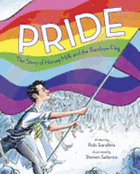
The life of Harvey Milk, one of the first openly gay people to hold political office in the United States, ended tragically: on November 27, 1978, Milk was murdered, along with the city's mayor, by a homophobic colleague. Older kids may be ready for the whole story, but Rob Sanders (Outer Space Bedtime Race) offers little ones an age-appropriate introduction to Milk through one of his overlooked contributions to the gay rights movement: the rainbow flag.
In Pride, Milk is first shown lying barefoot in the grass, mulling over his "extraordinary dream": that "everyone--even gay people--would have equality." He's next pictured speaking at a rally, and then it's on to the campaign trail in 1977: Milk has determined that "the best way to change laws was to help make laws." While organizing a march in opposition to laws that discriminate against gay people, Milk seizes on the idea of "a symbol that shows who we are and how we feel. Something to carry during the march." Milk asks artist Gilbert Baker to come up with the symbol, and with the help of volunteers, Baker creates the majestic rainbow flag that makes its debut on June 25, 1978, at San Francisco's gay pride march.
As Steven Salerno's (Brothers at Bat: The True Story of an Amazing All-Brother Baseball Team) illustrations attest, the flag has since become a versatile, international and ubiquitous symbol of gay pride. A two-page spread shows a dozen everyday people flying the flag in their own way. In the book's dazzler of a penultimate illustration, the colors of the rainbow are projected on the façade of the White House, as happened on June 26, 2015, when the U.S. Supreme Court legalized gay marriage. Surely Milk would have been smiling at--and taken, yes, pride in--that. --Nell Beram, freelance writer and YA author

